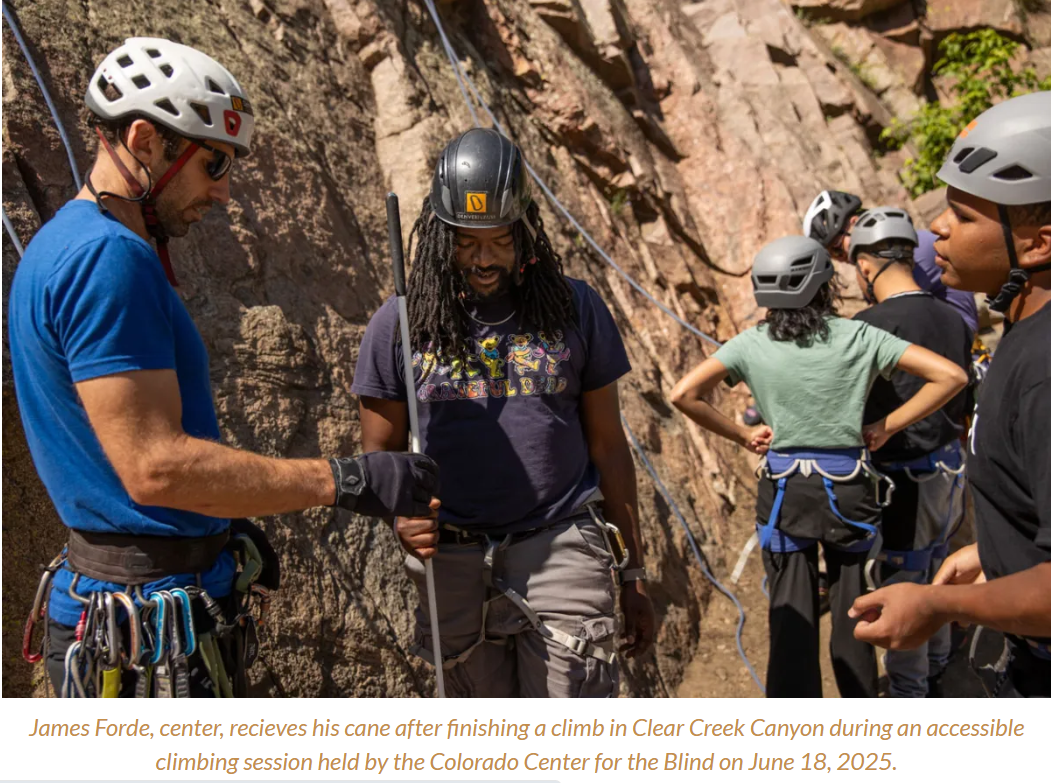Finding Freedom Outside: Outdoor Opportunities for the Blind and Visually Impaired in Colorado
Getting outside means something different to everyone. For folks who are blind or have low vision, it can be about independence, trust, and connection — not just with nature, but with the people who make it possible to experience it fully. Here in Colorado, that can look like scaling a cliff with a trusted belayer, using technology to explore a new park, or following a rope along a quiet forest trail.
Adaptive Adventures and Paradox Sports have been doing this work for years — creating spaces where blind and visually impaired climbers can show up, learn, and climb on their own terms. Adaptive Adventures keeps things approachable with clinics and community climbs across the Front Range. I have volunteered for this organization over the years in my home town of Fort Collins where they run climbing nights once a month at Whetstone and Ascent Climbing Gym. Paradox Sports, based in Boulder, builds community through trips and local sessions that mix new climbers, seasoned athletes, and volunteers into one supportive crew. These groups are living proof that outdoor recreation isn’t about ability — it’s about belonging.
photo credit from Colorado Outdoors
The Colorado Center for the Blind has been out there too, literally. Colorado Parks & Wildlife recently helped fund their climbing program, and the story “Reaching New Peaks” in Colorado Outdoors captured one participant’s experience perfectly: “I want people to know that we are just like everyone. Blind people also want to spend time outside. Climb rocks, white river rafting, go to the beach. Heck yeah, let’s do it all. Let’s go surfing!” That quote says it all. The bottom line is we all crave the same thing — freedom and connection in the outdoors.
Cycling is another way people are getting outside together. EyeCycle Colorado pairs blind and visually impaired riders with sighted captains on tandem bikes for group rides all across the Front Range. Their outings range from casual neighborhood spins to long weekend routes, and every ride builds trust and community. It’s not about speed or competition — it’s about movement, freedom, and the shared joy of being on the road with others who get it. They got a ride for New Years Day so there are still opportunities to get out there!
Photo Credit from Boulder Open Space and Mountain Parks
Colorado Parks & Wildlife has also made it easier for blind and low-vision visitors to explore parks independently through Aira, a smartphone-based service that connects users with trained visual interpreters. Aira agents can describe what’s around you, help with directions, or read interpretive signs — all in real time. One user put it simply: the program lets people “explore their neighborhoods, their worlds” with more confidence. It’s small tech with a big impact.
And for those who prefer to move at their own pace, Colorado has some truly special accessible trails. The Braille/Discovery Trail near Aspen has tactile guide ropes and Braille signs that make it easy to explore on your own. Down near Colorado Springs, the VIP Trail at Bear Creek Nature Center offers similar features — rope guides, tactile signs, and smooth surfaces. And in Boulder, the Sensory Trail winds through pine forest and wildflowers, encouraging visitors to notice the smells, sounds, and textures that most of us usually overlook.
photo credit from Eyecycle Colorado
All of these options — from adaptive climbing to sensory trails — show what’s possible when access is built into the design instead of added as an afterthought. Getting outside isn’t about checking a box or overcoming something. It’s about choice, joy, and connection.
So whether you’re clipping into a harness for the first time or just taking a walk to feel the sun and wind, know this: the outdoors belongs to you, too.
If there are specific areas you enjoy that I missed, please let us know so we can share them with the community!


